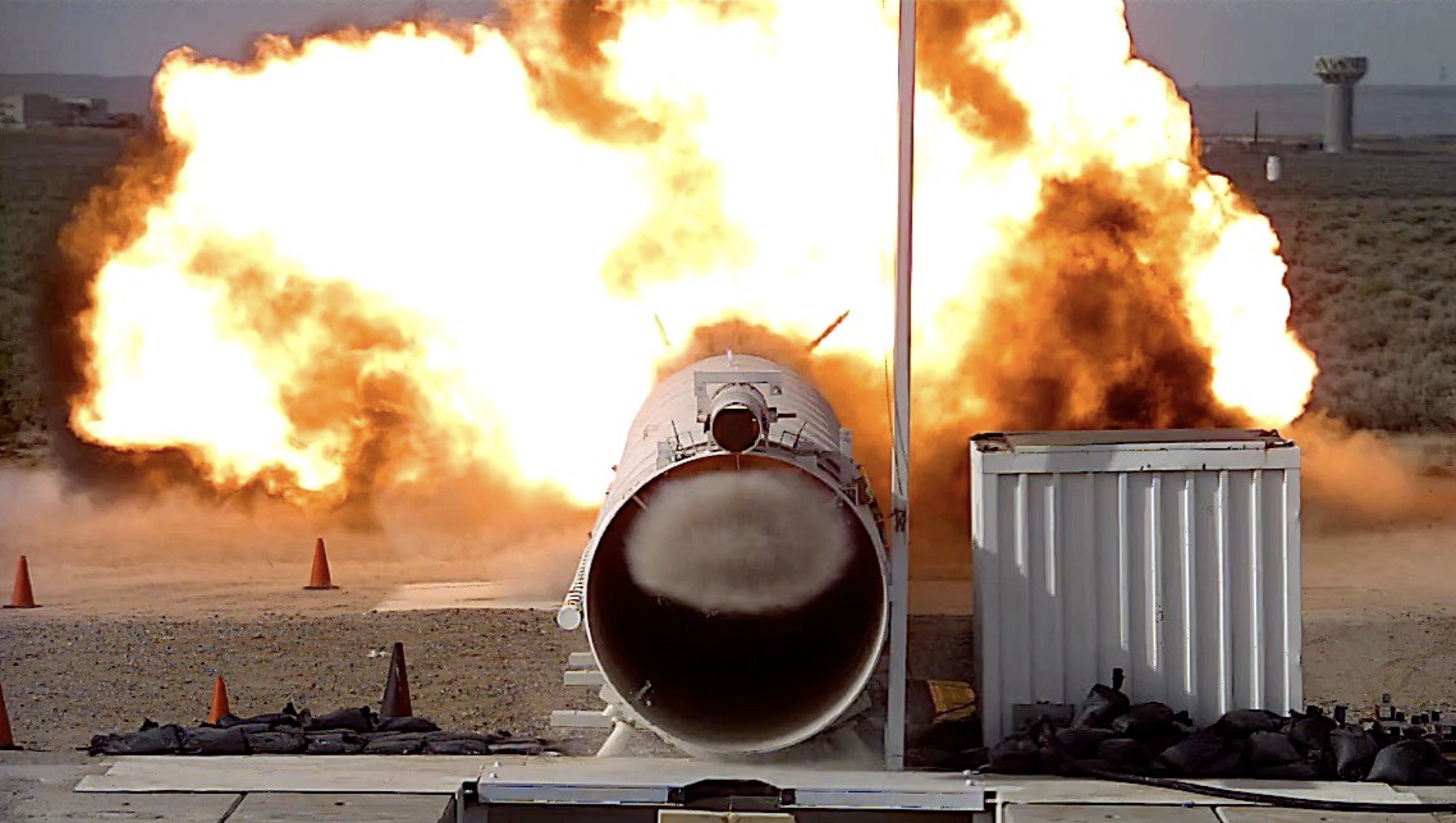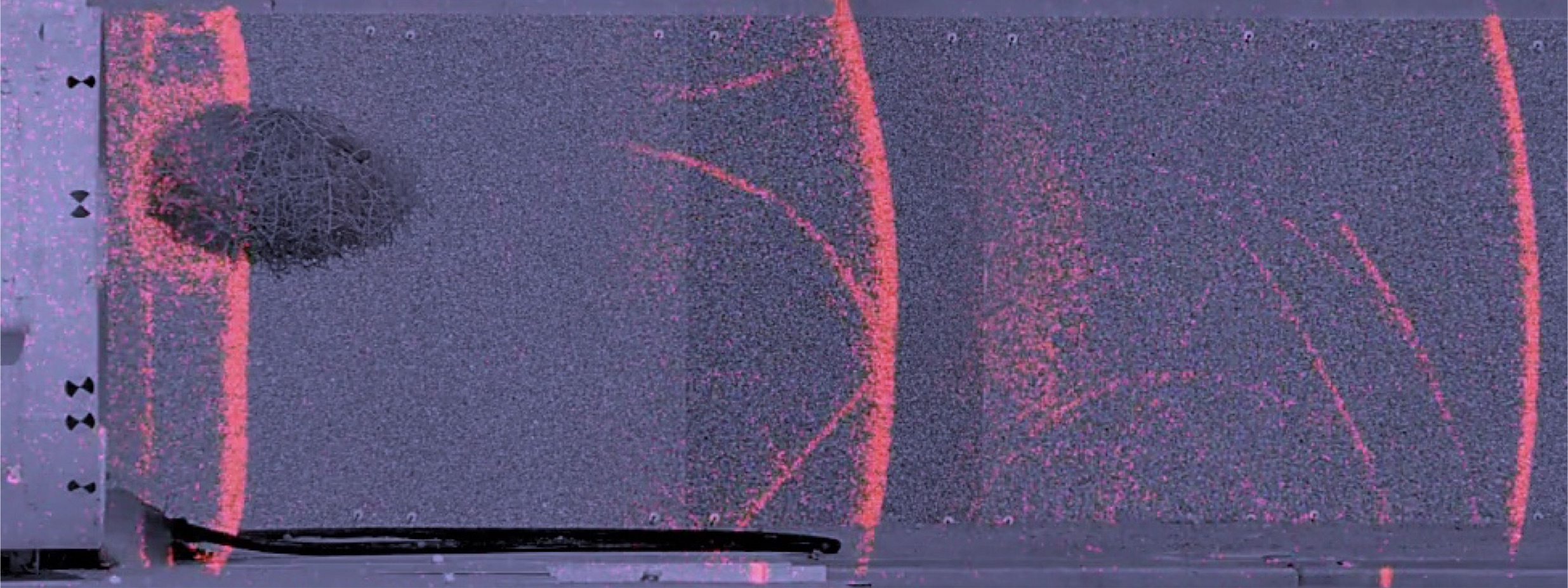ALBUQUERQUE, N.M. — You can learn a lot from a blast tube. You can learn more when you couple blast experiments with computer modeling.
Sandia National Laboratories researchers are using a blast tube configurable to 120 feet to demonstrate how well nuclear weapons could survive the shock wave of a blast from an enemy weapon and to help validate the modeling.
Click
to download the video (69 MB .MP4). (Video courtesy of Sandia National Laboratories) More blast tube videos are available on
by searching blast tube.
Sandia recently completed a two-year series of blast tube tests for one nuclear weapon program and started tests for another. Each series requires instrumentation, explosives, high-speed cameras and computer modeling.
Tests simulate part of the environment a weapon re-entering the Earth’s atmosphere would face if another nuclear weapon went off nearby, said test director Nathan Glenn.
Each series starts with calibration shots that allow team members to verify blast wave parameters and at the same time validate the computer model. The team hangs an explosive charge at one end of the 6-foot diameter tube and places pressure transducers along its length. Transducers sense the strength of the blast pressure moving through the tube — higher pressure closer to the charge, falling off farther away.
Modeler Greg Tipton, who helped design the series, said tests validate the computer models of the structural dynamics of the system. “We can then use the models to simulate real environments we can’t actually test to,” he said.
It’s complex just to analyze how to conduct a test, Tipton said. The pressure drives how big a charge is needed and how the test article is positioned in the tube, and that determines the loading, or the amount of force applied to the test unit. In turn, the loading determines the structural response of the test article. “So, the team does end-to-end calculations to simulate the explosive going off, the shock wave through the tube, the shock propagation over the test unit and then the structural response to the shock wave. All of that data is used to determine the right orientation, the right shock level, to validate the models,” Tipton said.

One software program simulates the explosive going off and the shock wave moving through the tube. A second calculates the shock moving over the test unit. A third computes the unit’s response to shock and vibration. The fourth simulates how the unit will fly from the tube so the team can estimate where it’s going, how fast it’s moving and how they’re going to catch it safely. Each software package has the dual purpose of computing the response of the system to validate the models and of helping design the test, Tipton said.
Software that simulates the explosive going off, for example, helps determine the size of the charge. “They do a number of shots in the tube to calibrate that. You know a charge weight and a pressure at some target location,” he said. “As you up the charge weight, you’re going to up the pressure, and if you do a handful of those tests and a whole bunch of simulations to fill in the blanks, you establish a calibration curve that tells you how much explosive you need to achieve a target pressure.”
Wil Holzmann, who helps analyze test data, said more than a hundred channels of data might be collected on pressures, strains and acceleration responses. Analysts process experimental data using embedded information and use identical signal processing methods to the experimental and analysis data and compare responses to assess the credibility of the model.
“The objective is to develop validated analytic models for predicting responses to blast loads with a high degree of confidence,” Holzmann said. Researchers can use the validated model to help qualify a weapon to withstand harsh conditions, such as a nuclear blast, that cannot be directly simulated with ground-level blast tube tests.
Planning takes much longer than test itself
Instrumentation is critical. Tests that last mere milliseconds require months of planning.
“Communication and technical excellence is crucial to success,” and there’s only one chance at getting data from the extreme environment of a blast, said John Griffin of Measurement Science and Engineering. “Simplicity in the design, protection of the hardware, redundancy of critical elements and thorough verification of connections are key to ensuring that we get the data in that one opportunity.”

Over the past three years, Sandia developed a new mobile instrumentation unit, a large-data acquisition system designed to self-check the accuracy and “health” of connections before and after testing.
A hardened trailer encloses the system so it can be placed near a blast test. The system can store up to 16 million samples per channel and record about 1 gigabyte per second at the maximum sample rate, Griffin said. For comparison, he said, this equates to more than 70 hours of digital music or about 1,100 songs.
Glenn said it’s more of an art than a science to measure pressure pulses. “If you don’t have it set up right and mounted right, the data is worthless,” he said. “There are racks and racks of instrumentation with wires coming at you. It makes your head dizzy just looking at it.”
Specialty high-speed imaging employed
High-speed imaging that measures pressure changes also helps assess a shock wave’s impact. In the past, researchers used streak cameras that viewed images through a quarter-inch by 6-inch slit. Streak cameras are similar to document scanners, imaging a column of pixels and generating an image by the object moving rapidly past the scan.

Now, a photographic technique called synthetic schlieren, implemented for harsh environments by optical engineer Anthony Tanbakuchi, enables a much larger view. Synthetic schlieren detects changes in optical index induced by changes in pressure, temperature and density. The schlieren effect is comparable to seeing ripples from heat on a road. Regular schlieren (a German word that means streak in the singular) techniques require large optics, special lighting and other complex, sensitive optical configurations that aren’t practical for large-scale tests, Tanbakuchi said. Synthetic schlieren doesn’t require any special setup other than an optional background and has no size limit because it looks for subpixel shifts in the background to detect optical index changes.
The team combines synthetic imaging algorithms with image stabilization codes Tanbakuchi developed to image a blast wave front. Sandia’s 50-year history of extreme testing means it has a huge code base to solve these problems.
Synthetic schlieren can be used for everything from pressure to temperature imaging. “But the most value comes when we also combine it with the data fusion techniques we’ve developed so you can see the pressure wave fronts with instrumentation data and model data,” Tanbakuchi said. “That’s when the full picture really emerges.”